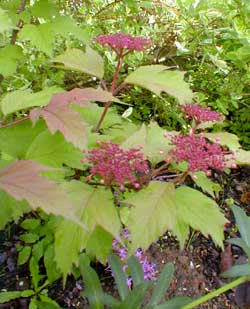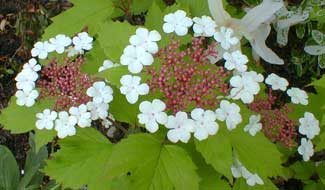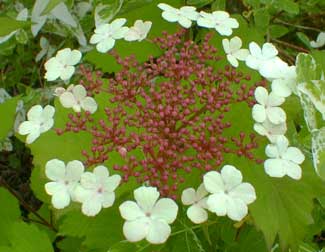
Sargent's 'Onondaga'
Highbush Cranberry
"Better than any argument is to rise at dawn
and pick dew-wet red berries in a cup."
-Wendell Berry,
b.1934
b.1934
'Onondaga' is a superior cultivar of Viburnum sargentiana (sometimes mistakenly listed as V. sargentii). Granny Artemis picked this out during the annual spring sale at the Rhododendron Species Foundation. We already had a very similar shrub, the American Highbush Cranberry Viburnum trilobum 'Wentworth,' which we so greatly love for so many elegant features that it was not possible to imagine another species could exceed it, but Sargent's 'Onondaga' out-shined the best.
For example, while 'Wentworth' has pale green lacecap flower buds that open to white (& for a while have a white "ring" of little blossoms around the central yellow-green buds), 'Onondaga' has a buds that are pink, as can be seen in the April photo at the top of the page (the year before, the pink buds waited until May). Both bushes' blooms open to become white, pure white for 'Wentworth,' while for 'Onondaga' a purplish hue can be detected even when the flowers are fully mature. It begins as a circle of tiny white blooms around a central button of pink buds rather than the yellow-green buds of 'Wentworth' (as can be seen in the second photo snapped in may). They both bloom from the outside inward until the entire lacecap is white.
 When 'Wentworth' releafs in spring, the leaves are an amazingly beautiful bright green. By contrast 'Onondaga' has the same maple-leaves but of a maroon hue upon their spring arrival, & as they mature to green, they retain a mahagony sheen, having a large purplish heart-shaped or fir tree pattern at the center of each leaf.
When 'Wentworth' releafs in spring, the leaves are an amazingly beautiful bright green. By contrast 'Onondaga' has the same maple-leaves but of a maroon hue upon their spring arrival, & as they mature to green, they retain a mahagony sheen, having a large purplish heart-shaped or fir tree pattern at the center of each leaf.Both shrubs have splendid autumn leaf color, but is most impressive on 'Onodaga' (see the Autumn Leaves Gallery: 'Onodaga' Highbush Cranberry Page for an idea of its Fall beauty). Both have berries that turn bright red by autumn (see the 'Onodoga' page of the the Pomes & Berries Gallery). Supposing they're not harvested by humans or birds, te berries will last on the the limbs without shrivelling or losing their color all the way to spring re-leaf. The berries on 'Wentworth' are larger & glassier.
A third species with extremely similar traits is European Highbush Cranberry, V. opulus. We don't have that species, discounting a Dwarf European Highbush which neither blooms nor fruits.
 Our 'Onondaga' in 2003 was just a three foot tall start of a shrub so didn't yet seriously compete with the V. trilobum which we have been successfuly training as an espalier forming one wall of our back porch. By late Spring 2004, the little 'Onondaga' had bulked up considerably; it is obviously going to be a toss-up which of these two highbush cranberries is best, both being ultimately remarkable, thugh on most days it seems that 'Onondaga' is more amazing than 'Wentworth.' They are planted in eye-shot of one another. They'll never look too much the same, because while the 'Wentworth' is trained nearly flat against the porch, the 'Onondaga' is being permitted to take its full width as a wilder shrub.
Our 'Onondaga' in 2003 was just a three foot tall start of a shrub so didn't yet seriously compete with the V. trilobum which we have been successfuly training as an espalier forming one wall of our back porch. By late Spring 2004, the little 'Onondaga' had bulked up considerably; it is obviously going to be a toss-up which of these two highbush cranberries is best, both being ultimately remarkable, thugh on most days it seems that 'Onondaga' is more amazing than 'Wentworth.' They are planted in eye-shot of one another. They'll never look too much the same, because while the 'Wentworth' is trained nearly flat against the porch, the 'Onondaga' is being permitted to take its full width as a wilder shrub.'Onondaga' is more strongly upright & compact than the species. It grows easily to six or eight feet, potentially higher, & though more compact than the wild form may yet need a bit of annual side-pruning if there is not room for it to become as wide as it is tall.
The lacecap buds become decorative somewhere between mid-April & early May. It is in full flower for most of May. The inner flowers of the lacecap open last & are the ones that will form the berries; they are smaller than the flowers around the rim which are sterile. Whether the center is still buds, or fully open, they are simply very showy.